Book contents
- Frontmatter
- Contents
- List of figures and tables
- Contributors
- Introduction
- PART 1 ANALYSIS AND RETRIEVAL OF DIGITAL CULTURAL OBJECTS
- PART 2 DIGITIZATION PROJECTS IN LIBRARIES, ARCHIVES AND MUSEUMS: CASE STUDIES
- PART 3 SOCIAL NETWORKING AND DIGITAL CULTURAL OBJECTS
- 7 Photos: Flickr, Facebook and other social networking sites
- 8 Searching and classifying affinities in a web music collection
- 9 Film retrieval on the web: sharing, naming, access and discovery
- Index
8 - Searching and classifying affinities in a web music collection
from PART 3 - SOCIAL NETWORKING AND DIGITAL CULTURAL OBJECTS
Published online by Cambridge University Press: 09 June 2018
- Frontmatter
- Contents
- List of figures and tables
- Contributors
- Introduction
- PART 1 ANALYSIS AND RETRIEVAL OF DIGITAL CULTURAL OBJECTS
- PART 2 DIGITIZATION PROJECTS IN LIBRARIES, ARCHIVES AND MUSEUMS: CASE STUDIES
- PART 3 SOCIAL NETWORKING AND DIGITAL CULTURAL OBJECTS
- 7 Photos: Flickr, Facebook and other social networking sites
- 8 Searching and classifying affinities in a web music collection
- 9 Film retrieval on the web: sharing, naming, access and discovery
- Index
Summary
Introduction
Online music libraries available on the web contain a large amount of audio content that is usually the result of digitization of analogue recordings or the direct acquisition of digital sources. The acquisition process is carried out by several persons and may last a number of years, thus it is likely that the same or similar audio content is present in different versions. This chapter describes a number of possible similarities, which are called affinities, and presents a methodology to detect the kind of affinity from the automatic analysis and matching of the audio content. The automatic detection of duplicates and nearduplicates of textual documents has become an important research trend after the development of the web. In fact the same textual information may be contained, with minor modifications, in several web pages maintained by different organizations or individuals. One of the reasons why a large number of near-duplicate pages exists can be tracked back to a general tendency on the web to underestimate the importance of copyright. In fact, near duplicate identification also has important applications in patent analysis and in plagiarism detection.
With the increasing availability of multimedia content on the web and in cloud services, duplicate detection is also gaining relevance for media other than text, in particular to help manage large video collections and to improve image retrieval tasks. Most of these approaches are based on the concept of fingerprinting as a way to reduce the very large scale of the problem. The basic idea of fingerprinting is that multimedia objects can be represented by a compact array of features, with a size orders of magnitude smaller than the original object, allowing feature indexing and in general faster processing. Moreover, a robust fingerprinting algorithm is able to extract features that are mostly related to human perception, in order to identify duplicates of a given multimedia object even when some post-processing has been applied.
The approach can also be applied to the music domain, and in fact acoustic fingerprinting is a well-known technique commercially exploited for music identification, which is at the basis of Shazam!, one of the most popular music services on the Internet, and of many other systems, such as the MusicID software patented by Gracenote and the AudioID software used by MusicBrainz based on an application of computer vision.
- Type
- Chapter
- Information
- Managing Digital Cultural ObjectsAnalysis, discovery and retrieval, pp. 183 - 198Publisher: FacetPrint publication year: 2016



